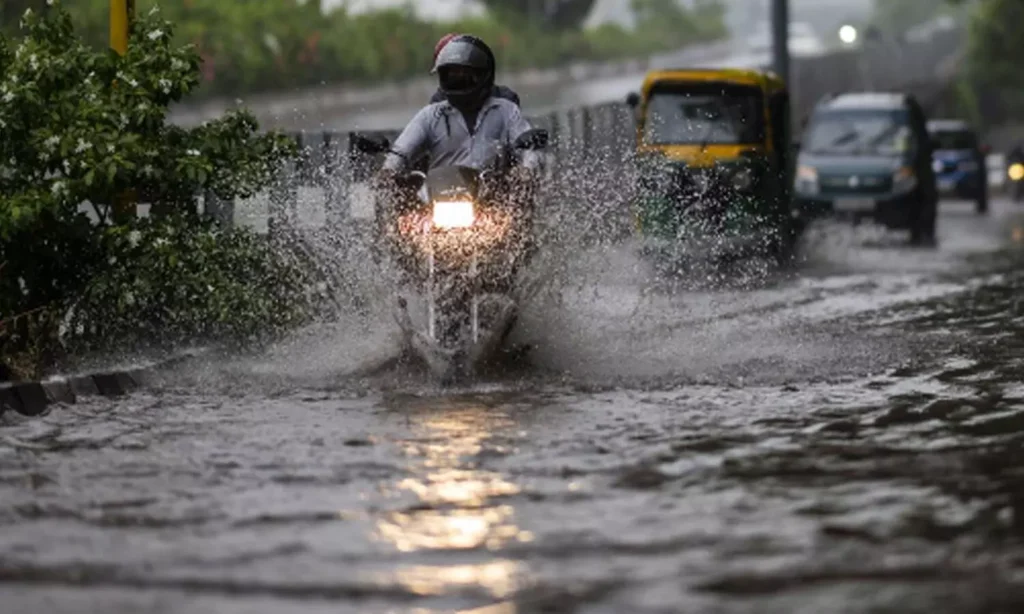The IMD 15-Day Monsoon Alert for Heavy Rain and Flood Risk in India 2025 has drawn national attention, especially as major cities like Mumbai, Delhi, Dehradun, and several hill states face threats of extreme weather events. With landslide warnings issued and rivers crossing danger levels, this IMD 15-day monsoon alert is not just a weather forecast—it’s a crucial call to action.
The IMD 15-Day Monsoon Alert for Heavy Rain and Flood Risk in India 2025 covers July 5–19 and includes critical updates that affect daily life, transportation, and safety across northern and western India. Let’s break down everything students, aspirants, and readers must know.
🌍 IMD 15-Day Monsoon Alert: What It Means
The IMD 15-Day Monsoon Alert for Heavy Rain and Flood Risk in India 2025 is issued by the India Meteorological Department (IMD) to warn states about potential cloudbursts, flash floods, urban flooding, and landslides due to sustained and intense rainfall over multiple days.
IMD uses satellite and radar data to predict these high-risk zones and shares daily updates, alerts, and advisories through TV, radio, and digital media.
📍 States Under IMD 15-Day Monsoon Alert for 2025
Below is the list of states most affected under the IMD 15-Day Monsoon Alert for Heavy Rain and Flood Risk in India 2025:
| Region | Forecast | Risk |
|---|---|---|
| Mumbai (MH) | Extremely heavy rainfall (July 6–9) | Urban flooding, traffic blocks |
| Delhi NCR | Heavy rain, thunder (July 6–10) | Waterlogging, power cuts |
| Uttarakhand | Continuous downpour | Landslides, blocked roads |
| Himachal Pradesh | Cloudburst risk in hill zones | River rise, mudslides |
| Uttar Pradesh | Scattered to heavy showers | Crop damage, village floods |
| Punjab & Haryana | Moderate to heavy spells | Overflowing drains, travel issues |
The IMD 15-Day Monsoon Alert for Heavy Rain and Flood Risk in India 2025 also includes alerts for Odisha, Bihar, Rajasthan, and parts of the Northeast.
📊 Why the IMD 15-Day Monsoon Alert Is Important
Helps disaster management teams pre-position relief material
Warns schools and colleges for possible holiday declarations
Alerts farmers about potential crop damage or sowing delays
Prevents travel chaos in flood-prone urban areas
By repeatedly emphasizing the IMD 15-Day Monsoon Alert for Heavy Rain and Flood Risk in India 2025, students and GK aspirants can understand how climate warnings connect to Geography, Environment, and Current Affairs topics.
🛑 Real-World Impact of IMD 15-Day Monsoon Alert
Mumbai local trains delayed due to waterlogged tracks (July 6)
Yamuna river levels rising in Delhi beyond warning marks
Highway shutdowns near Dehradun & Nainital due to falling rocks
Power cuts and outages across UP and parts of Bihar
✅ How to Stay Safe During the 15-Day Monsoon Alert
Following are basic but life-saving guidelines during the IMD 15-Day Monsoon Alert for Heavy Rain and Flood Risk in India 2025:
1. Avoid Travel in Peak Rain Hours
Floods and landslides can block roads suddenly. Stay indoors unless absolutely necessary.
2. Keep Emergency Kits Ready
Torch, battery, drinking water, basic medicines, and identity documents must be easily accessible.
3. Stay Updated via IMD App & Alerts
Download the ‘Mausam’ app by IMD or follow alerts on Doordarshan & AIR.
4. Disconnect Power During Flooding
Avoid electrical appliances if your home gets flooded.
🧠 Sample GK Questions:
Q: Which Indian cities are under the highest risk in the IMD 15-Day Monsoon Alert of July 2025?
A: Mumbai, Delhi, Dehradun, and Shimla.Q: What app can citizens use to follow the IMD 15-Day Monsoon Alert?
A: The ‘Mausam’ app by IMD.Q: Which river crossed the warning level in Delhi as per IMD’s 2025 alert?
A: Yamuna River.
🏁 Conclusion
The IMD 15-Day Monsoon Alert for Heavy Rain and Flood Risk in India 2025 is more than just a weather update—it’s a national safety bulletin. With multiple cities facing climate uncertainty and flood risks, understanding this alert empowers citizens and aspirants to stay informed, prepared, and responsive.
Make sure to follow verified IMD updates and stay connected to local disaster control centers if you’re in a red or orange alert zone.


I really appreciate this post. I’ve been looking everywhere for this! Thank goodness I found it on Bing. You’ve made my day! Thanks again